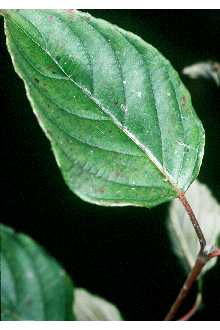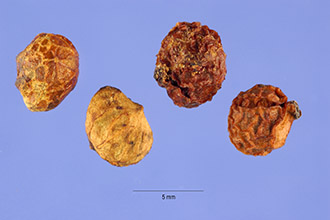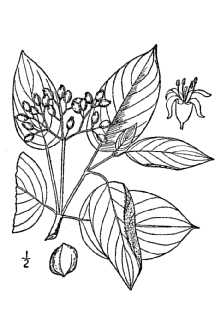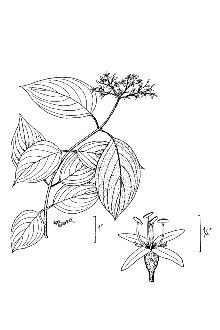Silky Dogwood
Scientific Name: Cornus amomum Mill.
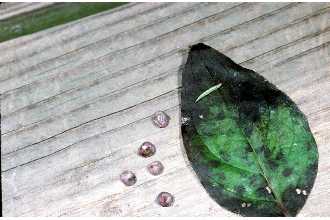
| General Information | |
|---|---|
| Usda Symbol | COAM2 |
| Group | Dicot |
| Life Cycle | Perennial |
| Growth Habits | Shrub |
| Native Locations | COAM2 |
Plant Guide
Use soil moisture sensors to measure the soil moisture of Silky Dogwood.
Fact Sheet
Alternate Names
Swida amomum (P. Mill.) Small
Uses
The primary use of this species is for field and farmstead windbreaks and wildlife borders. It is also being used with willows for streambank protection. Other beneficial uses are for fish and wildlife habitat improvement, slope stabilization, borders, and as an ornamental.
Status
Please consult the PLANTS Web site and your State Department of Natural Resources for this plant’s current status (e.g. threatened or endangered species, state noxious status, and wetland indicator values).
Description
Silky dogwood is a large shrub, often 6-10 feet in height. The growth habit is upright rounded, but where stems are in contact with the ground, roots are formed. This behavior creates thickets. Young dogwoods have bright red stems in the fall, winter and early spring, which turn reddish-brown in the summer. As the shrub matures, the stems turn reddish-brown year-round and later gray. Silky and redosier dogwood, though very similar, can be distinguished by their pith and fruit color. Silky dogwood has a brown pith in 1-2 year old stems, dark green ovate leaves, yellowish-white flowers which bloom in mid-June, and bluish colored fruit which matures in September. Redosier dogwood has a white pith, dark green ovate leaves, white flowers, and whitish colored fruit. There are approximately 12,000 seeds per pound. Robert H. Mohlenbrock USDA NRCS 1991. Southern Wetland Flora @ USDA NRCS PLANTS
Adaptation and Distribution
Distribution
Distribution
Silky dogwood is adapted from Michigan and Wisconsin to Maine and south to Georgia, Florida, and Tennessee, It has done exceptionally well in the Lake states, but poorly outside it’s natural range, It performs best in soils that are moist, somewhat poorly drained, moderately acidic to neutral, and in areas that have medium to coarse soils, Use soil moisture sensors to measure the soil moisture of Silky Dogwood., It is highly tolerant of shade but not of droughty conditions, For a current distribution map, please consult the Plant Profile page for this species on the PLANTS Website,
Establishment
Windbreaks: The site must be prepared by reducing weed competition. If equipment can be used, plow or disc the site first. If equipment cannot be used, clear sod from a one foot square area and plant as soon as frost is gone in the Spring. For bare root plants, holes should be dug deep enough to accommodate the entire root system. Space plants 5-6 feet apart in a row. If planting in a cluster, 8x10 or 10x10 foot spacing is advisable. Streambank stabilization: Steep slopes must first be graded. The slope should be 1:1 or flatter. Any trees considered unstable should be removed. One year old rooted cuttings should be used for planting. Plant in early spring, preferably before May. Do not plant after June 1. Plant the cuttings two feet apart for streambank erosion control, four to six feet apart for wildlife habitat. Establishment with other species, such as willow and other riparian species, is a good practice. On sites with banks that may become dry over the summer, utilize silky dogwood next to the water, with willows above. Immediately after planting, grasses and legumes may be planted to provide initial stabilization. After 2 or 3 years the dogwoods will become effective. Silky dogwood is vulnerable to livestock browsing. In order to ensure survival, fencing must be incorporated into the plan. Rooted hardwood cuttings are taken in January, allowed to develop callus in refrigerated storage, and planted in mid-May in well drained soil 2 inches apart. The cuttings should be 1/4-1/2 inch in diameter and 9 to 12 inches long. They should be planted with approximately 2 inches exposed above ground level.
Management
The planted areas should be examined each spring after the major runoff period has ended. Areas where vegetation has been destroyed must be immediately replaced with new plants. If any mechanical measures are being used to prevent erosion, they must also be maintained to prevent any more damage.
Plant Traits
Growth Requirements
| Cold Stratification Required | Yes |
|---|---|
| Hedge Tolerance | Medium |
| Hedge Tolerance | Medium |
| Frost Free Days, Minimum | 110 |
| Frost Free Days, Minimum | 110 |
| Fire Tolerance | High |
| Fire Tolerance | High |
| Fertility Requirement | Medium |
| Fertility Requirement | Medium |
| Drought Tolerance | Low |
| Drought Tolerance | Low |
| Cold Stratification Required | Yes |
| Temperature, Minimum (°F) | -38 |
| CaCO3 Tolerance | Low |
| CaCO3 Tolerance | Low |
| Anaerobic Tolerance | Medium |
| Anaerobic Tolerance | Medium |
| Adapted to Medium Textured Soils | Yes |
| Adapted to Medium Textured Soils | Yes |
| Adapted to Fine Textured Soils | Yes |
| Adapted to Fine Textured Soils | Yes |
| Adapted to Coarse Textured Soils | Yes |
| Adapted to Coarse Textured Soils | Yes |
| Moisture Use | High |
| Temperature, Minimum (°F) | -33 |
| Shade Tolerance | Intermediate |
| Shade Tolerance | Intermediate |
| Salinity Tolerance | None |
| Salinity Tolerance | None |
| Root Depth, Minimum (inches) | 16 |
| Root Depth, Minimum (inches) | 16 |
| Precipitation, Minimum | 36 |
| Precipitation, Minimum | 36 |
| Precipitation, Maximum | 60 |
| Precipitation, Maximum | 60 |
| Planting Density per Acre, Minim | 1200 |
| Planting Density per Acre, Minim | 1200 |
| Planting Density per Acre, Maxim | 4800 |
| Planting Density per Acre, Maxim | 4800 |
| pH, Minimum | 5.0 |
| pH, Minimum | 5.0 |
| pH, Maximum | 7.0 |
| pH, Maximum | 7.0 |
| Moisture Use | High |
Morphology/Physiology
| Active Growth Period | Spring and Summer |
|---|---|
| Toxicity | None |
| Toxicity | None |
| Shape and Orientation | Semi-Erect |
| Fire Resistant | No |
| Foliage Texture | Coarse |
| Foliage Texture | Coarse |
| Foliage Porosity Winter | Moderate |
| Foliage Porosity Winter | Moderate |
| Foliage Porosity Summer | Dense |
| Foliage Porosity Summer | Dense |
| Foliage Color | Green |
| Foliage Color | Green |
| Flower Conspicuous | Yes |
| Flower Conspicuous | Yes |
| Flower Color | White |
| Flower Color | White |
| Resprout Ability | No |
| Fire Resistant | No |
| Fall Conspicuous | No |
| Fall Conspicuous | No |
| Coppice Potential | Yes |
| Coppice Potential | Yes |
| C:N Ratio | High |
| C:N Ratio | High |
| Bloat | None |
| Bloat | None |
| Active Growth Period | Spring and Summer |
| Shape and Orientation | Semi-Erect |
| Fruit/Seed Color | Green |
| Resprout Ability | No |
| Nitrogen Fixation | None |
| Nitrogen Fixation | None |
| Low Growing Grass | No |
| Low Growing Grass | No |
| Lifespan | Moderate |
| Lifespan | Moderate |
| Leaf Retention | No |
| Leaf Retention | No |
| Known Allelopath | No |
| Known Allelopath | No |
| Height, Mature (feet) | 10.0 |
| Height, Mature (feet) | 7.0 |
| Fruit/Seed Color | Green |
| Fruit/Seed Conspicuous | Yes |
| Fruit/Seed Conspicuous | Yes |
| Growth Form | Stoloniferous |
| Growth Form | Stoloniferous |
| Growth Rate | Moderate |
| Growth Rate | Moderate |
| Height at 20 Years, Maximum (fee | 7 |
| Height at 20 Years, Maximum (fee | 7 |
Reproduction
| Propagated by Cuttings | Yes |
|---|---|
| Propagated by Seed | Yes |
| Propagated by Seed | Yes |
| Propagated by Sod | No |
| Propagated by Sod | No |
| Propagated by Sprigs | No |
| Propagated by Sprigs | No |
| Propagated by Tubers | No |
| Propagated by Tubers | No |
| Seed per Pound | 12200 |
| Seed per Pound | 12200 |
| Fruit/Seed Period End | Summer |
| Seed Spread Rate | Slow |
| Seed Spread Rate | Slow |
| Seedling Vigor | Medium |
| Seedling Vigor | Medium |
| Small Grain | No |
| Small Grain | No |
| Vegetative Spread Rate | Slow |
| Vegetative Spread Rate | Slow |
| Propagated by Corm | No |
| Propagated by Cuttings | Yes |
| Bloom Period | Early Spring |
| Bloom Period | Early Spring |
| Commercial Availability | Routinely Available |
| Commercial Availability | Routinely Available |
| Fruit/Seed Abundance | Low |
| Fruit/Seed Abundance | Low |
| Fruit/Seed Period Begin | Spring |
| Fruit/Seed Period Begin | Spring |
| Fruit/Seed Period End | Summer |
| Fruit/Seed Persistence | No |
| Propagated by Bare Root | Yes |
| Propagated by Bare Root | Yes |
| Propagated by Bulb | No |
| Propagated by Bulb | No |
| Propagated by Container | Yes |
| Propagated by Container | Yes |
| Propagated by Corm | No |
| Fruit/Seed Persistence | No |
Suitability/Use
| Palatable Browse Animal | Low |
|---|---|
| Palatable Graze Animal | Low |
| Palatable Graze Animal | Low |
| Palatable Human | No |
| Palatable Human | No |
| Post Product | No |
| Post Product | No |
| Protein Potential | Low |
| Pulpwood Product | No |
| Pulpwood Product | No |
| Veneer Product | No |
| Veneer Product | No |
| Palatable Browse Animal | Low |
| Nursery Stock Product | Yes |
| Nursery Stock Product | Yes |
| Naval Store Product | No |
| Naval Store Product | No |
| Lumber Product | No |
| Lumber Product | No |
| Fodder Product | No |
| Fodder Product | No |
| Christmas Tree Product | No |
| Christmas Tree Product | No |
| Berry/Nut/Seed Product | No |
| Berry/Nut/Seed Product | No |

